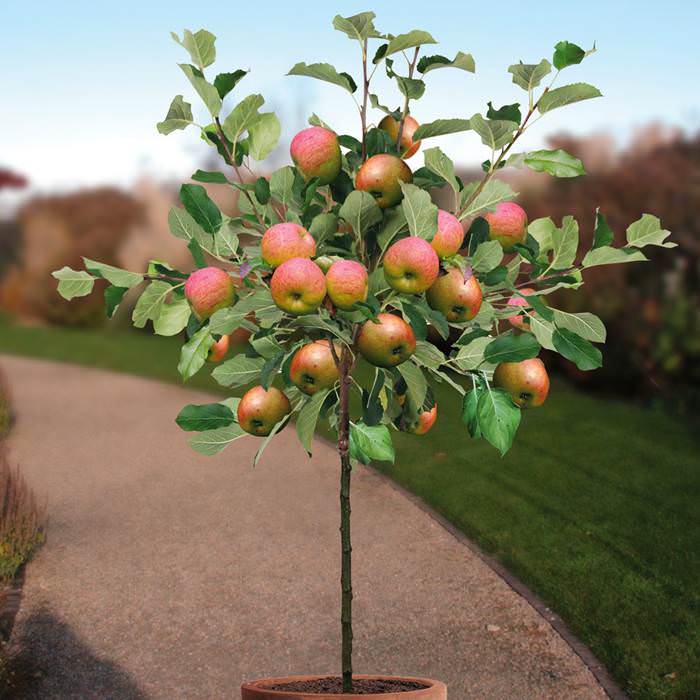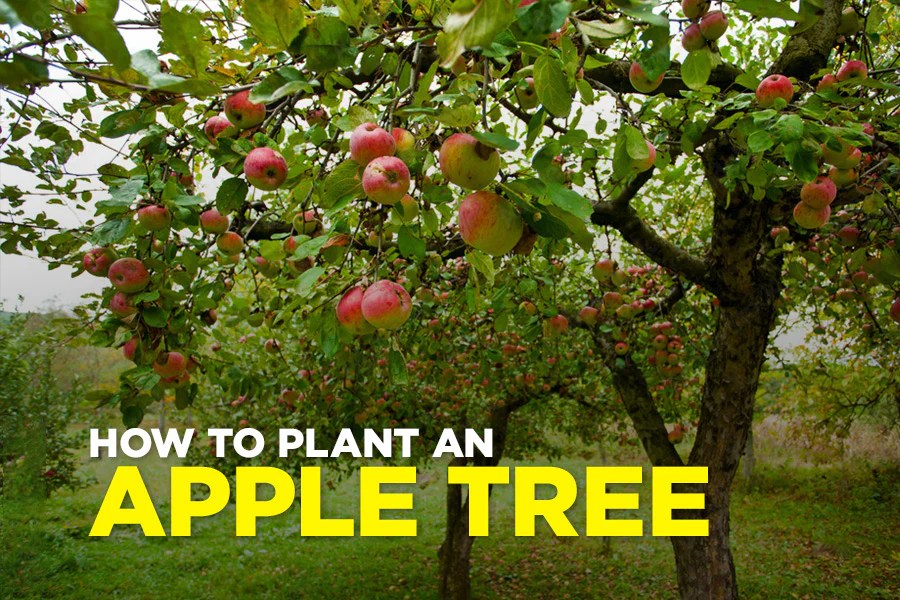Fruit Production from a Single Apple Tree

Can you plant just one apple tree – Planting a single apple tree might seem limiting, but with careful selection and maintenance, it can still provide a satisfying harvest. The yield, however, will naturally be less than an orchard of multiple trees, and certain factors significantly influence the amount of fruit produced. Understanding these factors is key to maximizing your single tree’s potential.
A single, well-maintained apple tree can produce a surprisingly substantial amount of fruit, especially when considering its size and resource allocation. The quantity depends heavily on the variety, growing conditions, and tree health. While a mature tree might yield hundreds of apples, expecting a bountiful harvest in the first few years is unrealistic; it takes time for the tree to establish a strong root system and mature sufficiently for significant fruiting.
Suitable Apple Varieties for Single-Tree Planting
Columnar apple trees are particularly well-suited for limited spaces, including single-tree plantings. These trees grow vertically, reaching heights of 8-12 feet but maintaining a narrow width of only 1-2 feet. This compact form makes them ideal for small yards or gardens where space is at a premium. Examples include the ‘Bolero’ and ‘Scarlet Sentinel’ varieties, known for their relatively high yields for their size.
Dwarf apple trees, while not as compact as columnar varieties, also offer a good balance between fruit production and space requirements. Popular dwarf varieties include ‘Honeycrisp’ and ‘Fuji’, both known for their delicious fruit.
While a single apple tree will produce fruit, optimal pollination often requires cross-pollination from another variety. Understanding the principles of fruit tree pollination helps determine planting strategies. This contrasts with citrus, where the best time to plant is crucial for successful establishment, as detailed in this resource on the best time to plant citrus trees. Therefore, the success of a single apple tree depends not only on the tree itself but also on environmental factors and pollination considerations.
Expected Fruit Yield from a Single Mature Apple Tree
The yield from a mature apple tree varies greatly depending on the cultivar, growing conditions, and care provided. A standard-sized mature apple tree can produce anywhere from 100 to 500 pounds of apples per year, but this is a broad range. Dwarf trees naturally yield less, often producing between 25 and 150 pounds annually. Columnar apple trees, due to their smaller size, will typically yield between 50 and 150 pounds.
It’s important to remember that these are estimates, and actual yields can fluctuate significantly year to year. A particularly good year might see a higher yield, while a poor year, due to weather or disease, might see a lower one. For example, a ‘Honeycrisp’ dwarf tree might yield 75 pounds one year and only 30 pounds the next due to a late frost.
Factors Affecting Fruit Yield
Sunlight, soil quality, and pruning practices significantly impact an apple tree’s fruit production. Apples need at least 6-8 hours of direct sunlight daily for optimal photosynthesis and fruit development. Poorly drained soil can lead to root rot and reduced fruit set. Regular pruning is essential to maintain the tree’s shape, promote air circulation, and prevent overcrowding, which can all negatively affect fruit production.
Proper fertilization, providing the necessary nutrients, is also crucial for healthy growth and a good yield. The application of appropriate fertilizers, timed correctly throughout the growing season, can make a significant difference in the amount of fruit the tree produces.
Factors Negatively Impacting the Yield of a Solitary Apple Tree
Several factors can negatively impact the yield of a single apple tree. It’s important to be aware of these to mitigate their effects and maximize fruit production.
The following factors can significantly reduce the yield:
- Pest and Disease Infestations: Apple trees are susceptible to various pests (aphids, codling moths) and diseases (apple scab, fire blight). Regular inspection and timely treatment are vital.
- Insufficient Pollination: Most apple varieties require cross-pollination from another compatible variety. If you have only one tree, you may need to hand-pollinate or plant a compatible pollinator nearby.
- Improper Watering: Both underwatering and overwatering can stress the tree, reducing fruit production. Consistent, appropriate watering is crucial.
- Nutrient Deficiencies: Lack of essential nutrients in the soil can hinder growth and fruit development. Regular soil testing and fertilization are necessary.
- Extreme Weather Conditions: Late frosts, hailstorms, and prolonged periods of drought or excessive rain can severely damage blossoms or fruit, reducing the harvest.
- Lack of Proper Pruning: Neglecting pruning can lead to overcrowding, hindering sunlight penetration and airflow, thus reducing fruit production.
Potential Challenges of Single-Tree Planting: Can You Plant Just One Apple Tree

Growing a single apple tree presents unique challenges compared to an orchard setting. While rewarding, successful fruit production requires careful consideration of several factors, particularly concerning pest and disease management, pollination, and overall tree health. Understanding these challenges and implementing proactive strategies is crucial for maximizing fruit yield and tree longevity.
Pest and Disease Management in Single Apple Trees, Can you plant just one apple tree
A single apple tree, isolated from other trees, can be particularly vulnerable to pest and disease infestations. Common apple pests include aphids, codling moths, and spider mites, while diseases such as apple scab, powdery mildew, and fire blight can significantly impact fruit production and tree health. The lack of natural pest predators in a single-tree setting can exacerbate these problems.
Strategies for Managing Pests and Diseases
Effective pest and disease management for a solitary apple tree relies on a combination of preventative and reactive measures. Preventative measures include selecting disease-resistant apple varieties, maintaining good tree hygiene (removing fallen leaves and fruit), and providing proper air circulation around the tree through pruning. Reactive measures involve monitoring for pests and diseases, and employing targeted treatments such as insecticidal soaps, neem oil, or organic fungicides only when necessary, following label instructions carefully to avoid harming beneficial insects and pollinators.
Early detection is key to minimizing the impact of infestations. Regular inspection of leaves, branches, and fruit is essential.
Pollination Challenges for a Single Apple Tree
Many apple varieties are self-incompatible, meaning they require pollen from a different, compatible variety for successful fruit set. Planting a single tree of a self-incompatible variety will result in poor fruit production, or no fruit at all, unless other compatible apple trees are nearby or alternative pollination methods are employed. Wind pollination is insufficient for many apple varieties.
Preventative Measures for Enhancing Tree Health and Longevity
To ensure the health and longevity of a single apple tree, a range of preventative measures should be implemented. This includes selecting a disease-resistant variety appropriate for your climate, planting in well-drained soil with adequate sunlight, providing regular watering (especially during dry periods), and applying a balanced fertilizer according to soil test results. Proper pruning techniques promote air circulation and sunlight penetration, reducing the risk of disease.
Mulching around the base of the tree helps retain soil moisture, suppresses weeds, and regulates soil temperature. Regular inspection for signs of stress or disease allows for timely intervention. Protecting the tree from extreme weather conditions through windbreaks or other protective measures can also contribute to its overall health and longevity.
Helpful Answers
What if my single apple tree doesn’t produce fruit?
Several factors can contribute to a lack of fruit, including insufficient pollination (even with self-fertile varieties), poor soil conditions, insufficient sunlight, or improper pruning. Review the tree’s environmental conditions and consider consulting a local arborist or horticultural expert for diagnosis and advice.
How often should I prune my single apple tree?
Pruning is essential for maintaining the health and productivity of your apple tree. The frequency depends on the tree’s age and variety, but generally, annual pruning in late winter or early spring is recommended to remove dead, damaged, or crossing branches and to shape the tree for optimal sunlight penetration.
What are some common pests and diseases affecting single apple trees?
Common pests include aphids, codling moths, and spider mites. Diseases such as apple scab, powdery mildew, and fire blight can also affect apple trees. Regular inspection and prompt treatment with appropriate insecticides or fungicides are crucial for maintaining the tree’s health.
